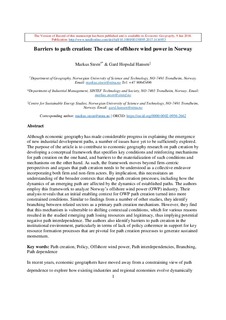Barriers to path creation: the case of offshore wind power in Norway
Journal article, Peer reviewed
Accepted version
Permanent lenke
http://hdl.handle.net/11250/2490577Utgivelsesdato
2018Metadata
Vis full innførselSamlinger
Sammendrag
Although economic geography has made considerable progress in explaining the emergence of new industrial development paths, a number of issues have yet to be sufficiently explored. The purpose of the article is to contribute to economic geography research on path creation by developing a conceptual framework that specifies key conditions and reinforcing mechanisms for path creation on the one hand, and barriers to the materialization of such conditions and mechanisms on the other hand. As such, the framework moves beyond firm-centric perspectives and argues that path creation needs to be understood as a collective endeavor incorporating both firm and non-firm actors. By implication, this necessitates an understanding of the broader contexts that shape path creation processes, including how the dynamics of an emerging path are affected by the dynamics of established paths. The authors employ this framework to analyze Norway’s offshore wind power (OWP) industry. Their analysis reveals that an initial enabling context for OWP path creation turned into more constrained conditions. Similar to findings from a number of other studies, they identify branching between related sectors as a primary path creation mechanism. However, they find that this mechanism is vulnerable to shifting contextual conditions, which for various reasons resulted in the studied emerging path losing resources and legitimacy, thus implying potential negative path interdependence. The authors also identify barriers to path creation in the institutional environment, particularly in terms of lack of policy coherence in support for key resource formation processes that are pivotal for path creation processes to generate sustained momentum.
